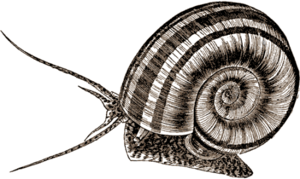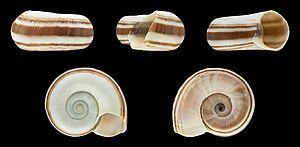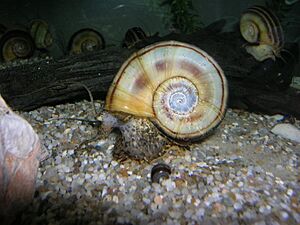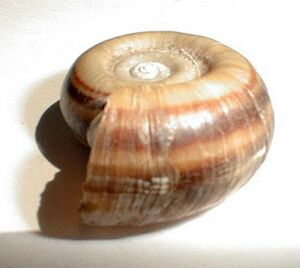Marisa cornuarietis facts for kids
Quick facts for kids Marisa cornuarietis |
|
|---|---|
 |
|
| Drawing of a live individual of Marisa cornuarietis: the visible soft parts are covered in dark spots. The edge of the round operculum is visible under the shell. | |
| Conservation status | |
| Scientific classification | |
| Synonyms | |
|
The Colombian ramshorn apple snail, known scientifically as Marisa cornuarietis, is a large freshwater snail. It's a type of aquatic mollusc that belongs to the Ampullariidae family, also called the apple snail family. These snails have a special lid called an operculum that can close their shell opening.
These snails are often kept in aquariums. They are also used in nature to help control certain pests.
Contents
Where Do Colombian Ramshorn Snails Live?
Native Homes of the Snail
This snail is found across northern South America and Central America. Its original home includes countries like Bolivia, Brazil, Colombia, Costa Rica, French Guiana, Guyana, Panama, Suriname, Trinidad and Tobago, and Venezuela.
Snails in New Places
Marisa cornuarietis has also spread to new areas.
- It was first found in Coral Gables, Florida, in 1957. Since then, it has spread to many parts of southern Florida.
- It was also found in Texas in 1983. Reports also show it in California and Idaho.
- These snails likely arrived in new places from people releasing them from aquariums.
- They are also found in Cuba.
In Europe, this snail is considered one of the worst non-native species.
What Does the Snail Look Like?
The shell of the Marisa snail is flat and coiled like a disc. This makes it look a bit like the great ramshorn snail. However, they are not closely related at all.
This snail is easy to spot because of its unique shell shape. The shell can be light or dark red or brown. It often has stripes. The shell usually measures about 35 to 50 millimeters (about 2 inches) across. Some can even be larger!
How Do These Snails Live?
Snail Breathing
This snail has both gills and a lung. This helps it breathe well underwater. It can even get enough oxygen when there isn't much in the water.
Where They Live
These snails prefer calm or slow-moving fresh water. They like places with lots of aquatic plants, as these are a good food source.
What They Eat
Marisa cornuarietis snails eat many things. They feed on aquatic plants, algae, and even dead fish and other snails.
They adapt well to living in aquariums. They are very good at cleaning up leftover food and waste. However, if there are too many of them, they can eat and damage aquarium plants.
Studies have shown that these snails can slow down the growth of water hyacinths. They do this by eating the plant's roots. Because of this, some people have suggested using them to control weeds in canals.
Life Cycle and Eggs
These snails have separate male and female individuals. They lay their eggs in special disc-shaped groups. These egg clutches stick to different surfaces underwater. Unlike some other apple snails, Marisa cornuarietis lays its eggs below the water's surface.
How Humans Use These Snails
In Aquariums
The Colombian ramshorn apple snail is a popular pet for freshwater aquariums. It is one of about 120 species in the apple snail family. Pet stores often sell them under names like "giant ramshorn snail." Sometimes, the name "Columbian" is used, but this is a mistake. The snail is named after Colombia, not Christopher Columbus.
People usually buy Marisa cornuarietis on purpose for their tanks. True ramshorn snails, from a different family, are often unwanted pests. They can accidentally enter tanks on plant leaves.
These apple snails grow much bigger than true ramshorn snails. They also eat a lot of plants. This means they are not the best choice for aquariums with many live plants.
Helping Control Pests
Marisa cornuarietis snails are used in biological control. They help reduce the number of Biomphalaria snails. Biomphalaria snails can carry tiny parasites that cause a disease called Schistosomiasis. The Marisa cornuarietis snails compete with Biomphalaria for food. They also eat the eggs of Biomphalaria snails. This helps lower the chances of the disease spreading.
These snails have also been released in some areas to control an invasive aquatic plant called Hydrilla.





